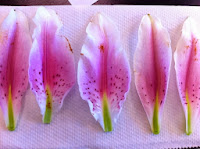Phylem: Cnideria
Cnideria are invertebrae animals that are different than most of the other animals because they are able to use their stinging cells to paralyze prey, capture food, and use it to defend themselves. Also refered to as Jellyfish considering the fact that most cnidarians are a type of Jellyfish. But don't forget Anemones and some types of coral are also part the the Cnidaria Phylem.
Here are some example of Cnidarians:
 |
| Jellyfish |
 |
| Sea Anemone |
Feeding:
Cnidarians are considered both Carnivores because of how they can paralyze their prey. They cannot actually chase after their prey like other animals, but instead they wait for some unlucky fish to just swim through them and hopefully get a snack out of them!
Respiration:
Cnidarians do not have lungs or gills! So how can they breathe? They respirate by exchanging gases through their entire body surface! That's right they have cells all around their body which allows them to exchange CO2 for O2.
Circulation:
Cnidarians don't actually have a Circulatory System. Instead they transport nutrients in a process called Diffusion. Diffusion is the process where the cells inside an organism transport nutrients throughout the body themselves instead of having arteries that push the blood found in humans.
Excretion:
Cnidarians only have one opening through their bodies which means that they ingest food and excrete waste all through the same opening. Pretty cool eh? But to be clear not all waste is excreted through their opening. Gaseous wastes are excreted through diffusion which is also pretty cool.
Response:
Cnidarians have a simple form of a Nervous System called the Nerve Net System. This means that the cells in the nervous system are spread farther apart than normal which allows Cnidarians to respond to physical contact. So wherever the Cnidarian feels contact automatically move in any random direction.
Movement:
Cnidarian moves with of the water current because of how weak their muscles are. So if the current is pushing left, the cnidarian will also travel left. They move by pushing water out of the their "Bell" top middle section of jellyfish/cnidarian to propel themselves.
Reproduction:
Depending on the specific Cnidarian, these animals can reproduce sexually by the male Cnidaria releasing sperm into the water in hopes that it will reach the female's eggs and get fertilized. From here the embryo are stored in the female's stomach or pouches along her oral arms until they are ready to be released. On the other hand, Cnidarians can also reproduce by budding which means that if a part of the animal breaks off, that part will grow into a new animal while the old animal will grow back what fell off! AWESOME! In other words, if I was a Cnidarian and lost an arm, my arm would grow back and the arm that fell off would grow a new body resulting in 2 Kenzie's!!!















































